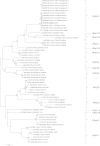Metagenomic analysis of viruses in feces from unsolved outbreaks of gastroenteritis in humans
- PMID: 25339401
- PMCID: PMC4290914
- DOI: 10.1128/JCM.02029-14
Metagenomic analysis of viruses in feces from unsolved outbreaks of gastroenteritis in humans
Abstract
The etiology of an outbreak of gastroenteritis in humans cannot always be determined, and ∼25% of outbreaks remain unsolved in New Zealand. It is hypothesized that novel viruses may account for a proportion of unsolved cases, and new unbiased high-throughput sequencing methods hold promise for their detection. Analysis of the fecal metagenome can reveal the presence of viruses, bacteria, and parasites which may have evaded routine diagnostic testing. Thirty-one fecal samples from 26 gastroenteritis outbreaks of unknown etiology occurring in New Zealand between 2011 and 2012 were selected for de novo metagenomic analysis. A total data set of 193 million sequence reads of 150 bp in length was produced on an Illumina MiSeq. The metagenomic data set was searched for virus and parasite sequences, with no evidence of novel pathogens found. Eight viruses and one parasite were detected, each already known to be associated with gastroenteritis, including adenovirus, rotavirus, sapovirus, and Dientamoeba fragilis. In addition, we also describe the first detection of human parechovirus 3 (HPeV3) in Australasia. Metagenomics may thus provide a useful audit tool when applied retrospectively to determine where routine diagnostic processes may have failed to detect a pathogen.
Copyright © 2015, American Society for Microbiology. All Rights Reserved.
Figures

References
-
- Harada S, Okada M, Yahiro S, Nishimura K, Matsuo S, Miyasaka J, Nakashima R, Shimada Y, Ueno T, Ikezawa S, Shinozaki K, Katayama K, Wakita T, Takeda N, Oka T. 2009. Surveillance of pathogens in outpatients with gastroenteritis and characterization of sapovirus strains between 2002 and 2007 in Kumamoto Prefecture, Japan. J Med Virol 81:1117–1127. doi:10.1002/jmv.21454. - DOI - PubMed
Publication types
MeSH terms
LinkOut - more resources
Full Text Sources
Other Literature Sources
Medical

